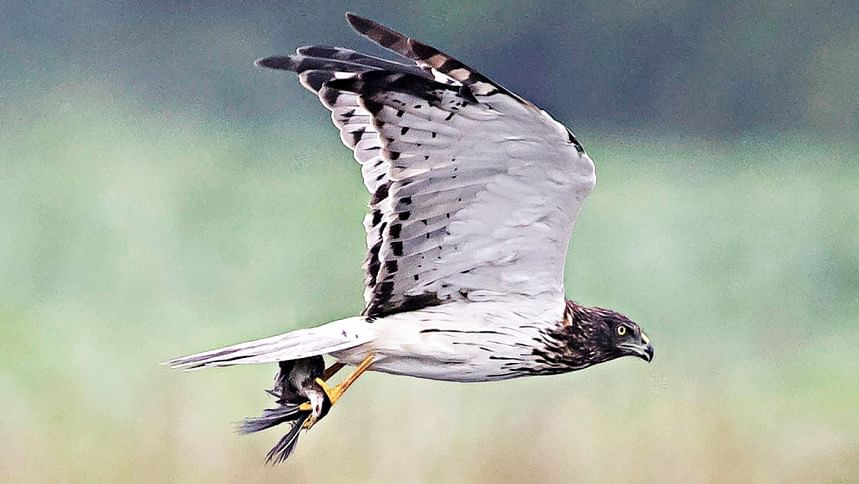Predators of Muhuri

Screaming loudly and wildly flapping their wings, the ducks abruptly took off from the water about two hundred feet from our boat. This alerted us to the proximity of a bird of prey. Sure enough, a solitary black and white bird approached from the distant horizon, coming closer as it circled the shallow water covered with Jol Kolmi, Chandmala, Kochuripana and other aqueous plants. Its head tilted downward, the bird intently scanned what lay below while it circled. It made its move suddenly, orienting its body downwards, tucking in its wings and kicking its feet before diving. Coming up empty-handed it resumed circling. After several attempts, it emerged from the dive clutching the lifeless body of a White-breasted Waterhen, its head resting limply against the mighty talons.
This drama unfolded before our eyes at a lake formed by a dam on the Muhuri river in Feni. During winter many types of birds congregate here including ducks, egrets and herons, jacanas, rails and crakes and migratory songbirds. But for me, the attraction of Muhuri lies in predators of the sky – her raptors.
A year ago I saw the magnificent Greater Spotted Eagle here, a large reddish bird with white spots on its body. It was sitting atop a small, submerged Mandar tree. This is a rare winter visitor to Bangladesh. I have also seen two resident eagles: Grey-headed Fish Eagle and Indian Spotted Eagle. The former nests high among the trees that surround the fishponds adjacent to the lake. The latter also breeds here, as I have seen both juveniles and adults.
Then there are the harriers. They own the skies above Muhuri.
Harriers are medium-sized hawks that fly low over the ground or water. Their flight profile is unmistakeable: long wings, narrow tails, flying with the head tilted downward, eyes often hidden by the span of their wings. They take their prey from the ground, including birds, small mammals and reptiles, using their hooked talons to catch, kill and carry.
There are sixteen species of harriers in the world. Six are seen in Bangladesh, most commonly the Eastern Marsh Harrier, Western Marsh Harrier and Pied Harrier. They fly over open spaces: marshlands, chars, haors and lakes. While harriers are winter visitors to Bangladesh, I have heard unconfirmed reports that some nest in more remote trees around the lake at Muhuri. I have seen harriers over the haors in Sylhet and the chars of Padma, but Muhuri is the best place for observing them.
Muhuri is a long but comfortable day trip from Dhaka. We left at 5 am by car. Driving the Chittagong Highway we arrived in Feni at 8:30 am and were at the lake at 9 am. The lake is best explored by boats available at the Tourist Spot. Rowboats rather than motor boats are preferable for birding as motor noise frightens the birds. Birding season lasts until early March, when migrant birds start disappearing but blooming Mandar flowers switch our attention to the myriad songbirds they attract.
Predator birds are usually shy and hard to find, but if you go to Muhuri in winter, you stand a good chance of seeing them.
facebook.com/ikabirphotographs or follow ihtishamkabir on Instagram.

 For all latest news, follow The Daily Star's Google News channel.
For all latest news, follow The Daily Star's Google News channel. 




Comments